Marquardt Butterfly
| This article requires additional photographic illustration — internals |
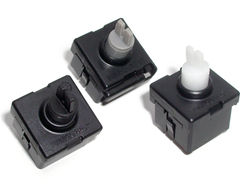 | |
| Manufacturer | Marquardt |
|---|---|
| Switch type | Clicky |
| Sense method | Metal leaf |
| Keycap mount | Marquardt mount |
Marquardt Butterfly is a provisional name for a series of clicky switches found in German-made Olympia typewriters. Not much is known about the origin of the switch but is clearly branded Marquardt on the top. The term "butterfly" is used as it describes how the leaf spring moves when pressing the switch.
Contents
Identity
Marquardt no longer remember these switches, and the official identity seems to be lost. No patent for them has been found, but German patent 3004665 filed in 1980 depicts a similar switch, with an identically-shaped shell, but a more typical keycap mount, and more straightforward internals. The butterfly leaf spring appears to be a revision of this design introduced shortly afterwards.
Description
A metal leaf spring with complex folds is placed down over the central terminal, onto which the return spring is also placed. The central portion of the leaf is cut through, and the cut ends sit in slot in the central terminal; the leaf by itself can then see-saw (vertically pivot), held entirely by the terminal. Grease is placed around the central terminal where the leaf fits into it.
One end of the leaf is then fed through a slot in the slider, which raises and lowers that end of the leaf. To cause the snap action to occur, the opposite end of the leaf must be prevented from exceeding a particular height. With the switch opened, you can find this maximum height using an implement such as a screwdriver. If the leaf is pressed down too far, it remains in permanent contact with the second terminal, while if the leaf can rise far enough, it is not bowed enough to achieve snap action. A protrusion in the lid provides this ceiling point.
Through snap action, the free end of the leaf jumps towards and away from the secondary terminal, giving instantaneous make and break accompanied by a click sound as the leaf snaps between states. The bottom of the leaf spring is gold plated at one end, as is the top of the terminal. The click sound is quite loud, and is comparable to IBM Beam Springs.
To reassemble the switch, the leaf spring must be pushed back down onto the centre terminal (which is quite fiddly) and the split ends fed into the slot into the terminal on each side. Once this is accomplished, it will see-saw smoothly on the terminal. Next, place the return spring onto the terminal, and insert the slider; the leaf should feed through into the slider readily, at which point the lid can be placed. Once the lid is pressed down, it may be necessary to give the switch a hard push to release the leaf spring into action.
The flat spring construction appears to function similarly to stacked spring, giving the switch a distinct amount of hysteresis, somewhere in the region of 1 mm (something that is quite difficult to measure with callipers). Testing with a multimeter demonstrates that actuation occurs at the point that the click sound is generated, and the contact release occurs at the point that the hysteresis is cleared, where a second click is emitted. Unlike stacked spring, while the return spring sits on the leaf spring it does not appear to influence it.
The terminals are held in place by twist mounting: they are placed through rectangular holes, and then the exterior portion is twisted so that they cannot be pulled back through the holes. To remove the terminals, use a small pair of pliers to rotate the exterior portion of the terminal back to the same orientation as the holes; they will then readily drop through when the switch is held upside down.
Keycap mount
The keycap mount is two plastic prongs, each approximately 1 mm × 2.5 mm in cross section and around 4.9 mm tall, with a 1 mm gap between them.
The keycap mount of the Marquardt Two Fingers Typewriter switch and the butterfly switch are compatible, with keycaps interchangeable between the two.
(Perhaps these keycaps were also compatible with some mechanical typewriters?)
Variants
| Switch | Description | |
|---|---|---|
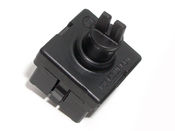 |
The black one | Standard switch |
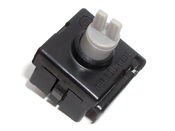 |
The grey one | Multi-switch operation |
 |
The grey one | Alternate action |
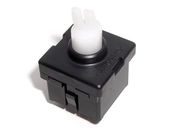 |
The white one | Double action |
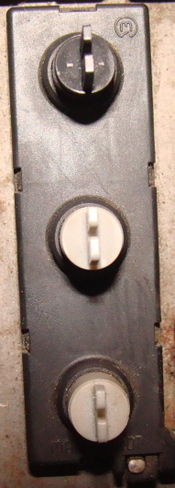 |
Olympia multi-switch module | Multi-switch operation |
Head-to-head press tests indicate that black actuates first, then white, then grey, yet all three types have the same spring.
Black
The black switch is the standard momentary single pole switch.
The depicted switch is NOS from STRONIC in France.
Grey
The discrete grey switch facilitates multi-switch operation. The switch contains a small control bar that is extended when the switch is pressed. This bar rotates a metal rod that runs the width of the alphanumeric area, and is likely part of a shift lock mechanism where shift lock is released by pressing either shift key. The control bar is not self-closing: a spring in the multi-switch module will be return the control rod to its rest state, and this will push the control bar home. In the illustrations below, the switch is held vertically to allow gravity to retract the control bar. A cam on the slider is used to push the bar sideways as it is depressed.
The depicted switch is NOS from STRONIC in France.
Grey Alternate action
Alternate action version.
White
The white switch is double action. It has a second pair of terminals, arranged perpendicularly to the normally-open terminals. These provide stage two of the double action mechanism. Just as with stage one, stage two provides click feedback and hysteresis.
Both internally and externally, the second pair of terminals are surrounded by a powdery clear foam that rubs off readily. The stage two mechanism lives inside a sub-assembly partially hidden inside the foam-covered enclosure moulded into the switch. These mechanism is partially exposed, allowing it to be engaged by the slider.
The depicted switch is NOS from STRONIC in France.
Olympia multi-switch module
Olympia typewriters with Butterfly switches use a three-way multi-switch module on the left side of the alphanumeric area. The front and centre switches are grey and the rear switch is black. The likely explanation is that the two grey switches form a latching shift lock with remote release (by pressing either shift key). Existing photos of the insides of this module don't quite clarify the functionality of this module.
The module is completely indivisible: it is not three switches semi-permanently attached, but rather a single moulding divided into three switch units.
Keyboards
- Olympia ES 101 electric typewriter (ca. 1981)[1]
- Olympia Professional ES 105 electric typewriter (ca. 1983)[2]
- Olympia Professional ES 105 electric typewriter (ca. 1983)[3]
- Olympia Disque electric typewriter[4]
- Olympia ES 110 electric typewriter[5]
- Olympia ES 100 electric typewriter[6]
References
- ↑ Flickr - Olympia ES 101 Retrieved 2015-07-28.
- ↑ Google+ — Olympia Professional ES 105 Dated 2012-09-29. Retrieved 2015-07-28.
- ↑ Deskthority — Olympia Professional ES 105 Dated 2012-09-16. Retrieved 2022-10-18.
- ↑ Deskthority - Olympia Disque Retrieved 2018-03-02.
- ↑ Deskthority - Olympia ES 110 Retrieved 2019-11-13.
- ↑ Deskthority - Olympia ES 100 Retrieved 2021-07-08.












